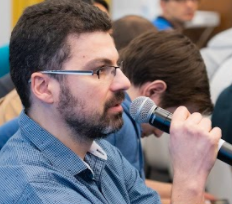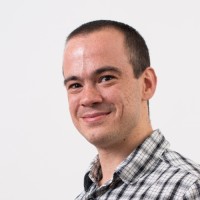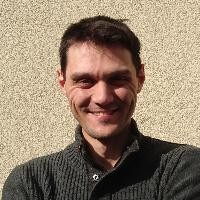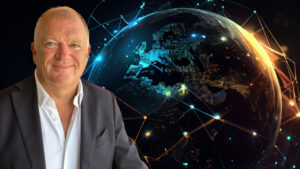5 Days at Hyperscience: The Machine Learning Startup With $111m Investment That Turns Paper Documents Into Data
“5 Days at…” is a Trending Topics original series in which we get a 360 perspective into interesting product companies in SEE. In this edition, we are spending some time with Hyperscience, the started in Sofia in 2014 that turns paper documents into machine-readable data using machine learning. Their customers are organizations that typically receive huge amounts and a variety of paper documents – the financial services sector, government, healthcare, and insurance industry. So far, the company has raised over $110M from leading VCs such as Bessemer Venture Partners, Stripes Group and Firstmark Capital, and has grown to 100 people spread between the three offices in Sofia, New York and London.
For five consecutive days, we are spending 5 minutes with people from Hyperscience to find out what’s their secret sauce.
In order to complete its ambitious plans for 2020, Hyperscience is hiring in all of its departments: take a look at the career opportunities.
Day 1: Boyan Kelchev, Product Manager at Hyperscience
Boyan Kelchev has quite interesting experience both in engineering and product roles between Valencia, Toledo, San Diego, Boston, and Silicon Valley. He’s also done a project or two with the Massachusetts Institute of Technology before joining Hyperscience as a product manager, based in New York.
Trending Topics: What brings you to Hyperscience? What excited you about the company?
Boyan Kelchev: What brought me to Hyperscience, is also what keeps me here and excites me about the company every day. There are a couple of things I’d like to highlight. One of them is the connection to Bulgaria. The ability to work in a company that spans to three different offices around the world is very important to me, and I have the added benefit of speaking my mother tongue with my colleagues on a daily basis. The other two reasons are the business and the people. When it comes to business, I have a quick story to share. I met the VP of product of Hyperscience a couple of years ago at an event in New York City, the event was about machine learning and enterprises. What stuck with me was a story about a very particular project they were doing with a large federal agency in the US. It was one of the very few concrete use cases of machine learning being applied in enterprise I had heard about. It really had a large impact on a particular problem the government was seeing. And so having a business model with the very concrete impact that you are providing to your client s is something that not that many companies can ghost about, especially so early in their journey.
Then the people are important, of course. Once I was offered a job at Hyperscience I spoke to a friend of mine from a VC firm and she helped me do a little bit of due diligence about the company before I joined. A consistent message I was hearing from a lot of the people she talked to was that the people at Hyperscience are smart, hard-working and grounded.
That’s an interesting approach. One of the things we often ask when it comes to startups is whether they have a stable business. What’s the situation with Hyperscience?
Today the company is in a very different stage and place than it was when I started here a couple of years ago. We’ve attracted a lot of venture capital, and our business is very very healthy right now. Hyperscience got a great product-market-fit fairly early on. Part of it is luck, and part of it is the execution of the team. The problem that we are solving is very important to our clients today, it was two years ago, and today, especially in the environment of Covid, we see it becoming more and more important because it helps our clients automate processes and be more efficient.
What does your role actually include and how closely do you work with the engineering team in Sofia?
Like any product manager, my job is to deliver the right products to the customers’ hands. This translates into a couple of different things. One is doing research and understanding the industry that we operate in, also the pain points of our customers for which I work closely with the customers success team. I work a lot with our product marketing managers and read reports on the industry, look at what our competitors are doing, etc. And then, after the research, another big part of my work is communicating new opportunities for engineering and other parts of our company. Our engineering is very busy, on daily basis they work on very complex projects, and they don’t have much time to learn about the industry and the competitors. So the ability to synthesize this information and provide it in a digestible form is a very important part of my job.
What are Hypersciences’ plans for 2020?
We have quite ambitious plans. One of the thighs that we look at is to open up towards new verticals and use cases. What we do today is extracting information from documents and providing it in a structured format to other software systems. We are now thinking of going into much more complex use cases and trying to model entire business processes. To be able to do this, we’ll also have to grow our team and we are right now hiring in almost all departments of the company.
Day 2: Peter Levi, Staff Software Engineer
Peter Levi is an experienced full-stack engineer with 19 years of experience in different tech companies, who chose to spend the past four and a half of them at Hyperscience, which is also the first product company he works at.
Trending Topics: You are one of the first team members of Hyperscience which originates from Sofia. What brought you here?
Peter Levi: Chance. 4 years ago it was an early startup, veiled in mystery. My first impression was “Are these guys even real?”. Even the website was strange and geeky. But back then Hyperscience was (and still is) one of the few companies in Sofia actively working on actual ML projects. This was interesting to me. The time was also right for me for a change.
All the people I met at the interviews were really smart, this was a major factor. The description of what they were doing was a bit vague and unconvincing, I even thought “Will I be jobless in 6 months?”. Still, I chose to believe them and jumped in. The vision of the company changed quite dramatically several times since then and eventually, things started making sense.
What exactly is your role, what are your responsibilities and which are the teams/ departments you work most closely with?
My role has been quite diverse in these 4 years, as the company evolved and changed shape a lot. I consider myself a “universal” developer and like to have a good grasp of all technology tiers. I’ve worked on some of our early ML solutions. I’ve led our Frontend team and a couple of UX-heavy projects with React, even took the designer role for one. I’ve occasionally taken some DevOps-related initiatives. The architecture of some of our subsystems is my work. Recently I’ve been working mostly on user-facing features of our product, the work being split between the Django backend and the React frontend.
When I joined, the company had practically only one department, engineering, and we were only doing ML and systems work. It was a geeky place, so no surprise the website was geeky too… At one point we needed some UIs done. It was only me and a couple of other people who had any sort of frontend know-how. We started interviewing and building a front-end team and somewhere around that time the teams really started to form. We now have a fairly firm division between application and ML teams and I’ve been working mostly in the application teams.
I often work closely with colleagues from Product in order to resolve the huge amount of ambiguity we deal with. Our product is a complex mix of non-trivial ML parts, coupled with human-in-the-loop parts that require a fast and smooth UX, so projects often benefit from someone with cross-functional experience to help with the right balance between these two diverse aspects of it.
I also work closely with our designers when defining the UIs, help with ideas there, come up with designs myself from time to time. And of course, I work with all the engineering teams too.
What are the products and features you are working with? What are the specifics?
Most recently I’ve been working in the team that deals with the way layouts are defined in our system. Our product helps companies process their incoming documents. Most often these are filled-in predefined forms – you can think of an insurance claim or an account opening form as an example. Before we can process these, customers need to specify how they look, which fields to extract, set the data types, and so on.
It’s a hairy problem once you dig into the details. There’s editing similar to that in image-editing software. Versioning as in a version control system such as git. Import, export. The defined fields need to be compatible with the ML backend that processes them, and it constantly evolves. Some customers have so many forms they don’t know all the variants that are out there, so we even have a tool to suggest new layouts using unsupervised learning. But we also need to support the simple use-cases of a small organization or a sales demo. This illustrates why sometimes the product and design phases are filled with ambiguity, compromises, even heated discussions.
What technologies are you working with and what do you personally find most exciting?
Our tech stack is fairly mainstream and well-established, but also sufficiently current and modern. We use Python, Django and Django REST Framework on the backend. React with TypeScript on the frontend with a bit of Redux that we are slowly replacing in favor of pure React with hooks. The UI is in the form of a single-page web application. The backend and background jobs run in Docker containers, on-premise in our clients’ infrastructure. Data is stored in one of several supported relational databases. By the way, we have made several contributions to Django as its support for Oracle and MSSQL was a bit flaky in places. For the ML models, we use both TensorFlow and Torch.
The most exciting parts for me lie not in the technology stack, but in the variety of different challenging problems that we have to solve, in dealing with the ambiguity around some of those problems, in the heated discussions as we seek the perfect solution, the right balance between what needs to be done, what ideally we would love to do and what we actually have time to do. Oftentimes the implementation itself is quite challenging on its own. But, the harder the battle, the sweeter the victory!
Day 3: Ivo Stranjev, Director of Machine Learning
Ivo Stranjev has been part of Hyperscience since 2016 taking various roles. He’s quite well known in the tech community in Sofia as part of his calling is also teaching.
Trending Topics: Can you briefly walk us through your journey with Hyperscience? You joined the company in its very first weeks…
Ivo Stranjev: When I joined we were about six people in the company. Bac then we used to do short projects of one to two weeks and now we are focused on just one product that we develop. It has become a great product that is very appreciated by customers. Every single day I see us grow and mature even more. I don’t think we are a startup anymore, we are more of a scaleup. I’ve learned so much along the way, it’s very exciting to be part of this.
What exactly is your role, what has changed in it?
Initially, everyone was doing everything, and we eventually became more specialised. I’ve done a lot of things – I was a full-stack engineer, then I became a machine learning engineer, after that I was leading one of the machine learning teams, and currently, I’m the director of machine learning in Sofia. My current role consists in connecting the ML part of the company with the other departments and being the person to give information to the ML teams, mostly from the go-to-market department – the sales, marketing and customer success teams. I’m also reporting on the progress towards the goals that were set.
What are the challenges that you need to solve in your role and what do you find most exciting? Are there any cool projects and features that you are working on and will be on the market soon?
The biggest challenges are related to setting the longer-term perspective – not only thinking about the immediate month but also about the agenda for the next year. We are working on a lot of exciting projects at the ML department. Currently, we are working on several fronts – we are trying to make out text recognition several times faster. This means that it will not only be state of the art, but it will also be very very fast. Another interesting thing is the table automation. Before I started working on this I thought tables are something simple and easy to solve, but it turns out there are a lot of weird tables out there – especially in the insurance industry. So we expect this to come out in the next quarter or so.
You are quite active in the engineering and ML communities. What do you think are the most important skills that professionals in this domain need to gain. Are there any interesting trends you are observing?
I really like the fact that we try to grow the community by educational activities, I’ve always enjoyed teaching. On the other hand, I really like that we are driving automation and making people’s lives easier.
For me, technology is a tool that everyone can learn. In particular, the typical technological stack in ML is Python, TensorFlow, and Torch. These are the major ML technologies nowadays. In my opinion, one of the most important skills is to set deadlines and be able to figure out on time when an experiment is unsuccessful. And the other thing is, of course, we are solving problems no one has solved before, so we need to come up with innovative solutions, you need to know-how innovation is done. Last but not least, there are a lot of publications nowadays, you need to be able to identify the real ones and real results among all publications out there.
Can you share some examples of innovations you are doing at Hyperscience?
Our text recognition software is state of the art by a huge margin, and it’s built with classical building box, that are combined in a way that they are contributing to the problem we are trying to solve greatly. We have done several innovations in document processing and extracting information from documents.
Day 4: Dimitar Kovachev, Staff Software Engineer
Dimitar Kovachev is a seasoned professional with more than 18 years of software engineering experience and a track record of delivering high-quality solutions.
Trending Topics: What’s your story with and within Hyperscience?
Dimitar Kovachev: I joined the company four years ago. Over those four years, I’ve been working for various products – from fairly simple ones like Proof of Concept for customers, to some internal systems, and eventually, in the past two years, I’ve started working on the main product of the company.
How is your engineering department organized and what are the methodologies you are using? Are there any specifics?
We are using primarily agile and scrum type of day-to-day organization without going into too much dogma, We are using the high-level rituals that work for us.
The engineering teams are sized between five and seven people, depending on whether we count also the QA engineers and the designers. We are mostly spread between Sofia and New York, and we always have at least one or two team members that are in the other office. This is a particular decision we made because we want everything to be spread geographically so we don’t lock up knowledge and know-how. We have 4-5 purely engineering back-end teams, there are also 4 ML teams.
What keeps you up to date and in good professional shape?
It takes a good amount of effort to stay up to date. We have a particular tech stack that we are using, and every single piece of it is always moving and evolving there are new versions of the frameworks all the time so on the one hand, we are forced to use them for security reasons. At the same time, we are always on the active lookout for new stuff, because new ideas and technologies pop up all the time, and something that was not viable three months ago, could have matured and be a better fit in the whole picture now.
When you joined you were a handful of people and you are now over 100 people. What helps you feel part of the big picture?
It’s being able to work with cutting edge technologies and to have a company of really smart and talented people all around you. It’s definitely something that is pushing you forward all the time.
Day 5: Svetoslav Neykov, Director of Engineering
Svetoslav Neykov is a senior back-end software engineer with 20 years of experience who joined Hyperscience in 2017 and has changed three roles gradually becoming Director of Engineering.
Trending Topics: What exactly are you doing at Hyperscience?
Svetoslav Neykov: I’m the director of the Intelligent document processing engineering department. This is where the main product is created. Lately, I’ve been focusing on defining the roadmap for my teams by the end of the year, and also planning out hiring efforts.
What is on the roadmap for 2020?
We have a very aggressive roadmap, 2020 will be a very interesting year because we are rethinking the basis of what our product does, and we are expanding it to cover many new use cases and new customer verticals. The goal at the end of 2020 is to be able to serve a wider customer base.
How do you make sure that you are really up to date with what customers need? Also, how do you make sure that the teams understand that they are bringing value to the customers?
For us it’s very important to get feedback from the customers, it’s a key factor for our development. Therefore, we have a very good customer experience team, and a product team. Customer experience teams work closely with the existing customers, making sure they have what they need, collecting feedback, etc. On the other hand, the product team is looking into the future discovering new features, of course, again working closely with existing customers, and prospective customers. We have regular knowledge sharing sessions companywide where members of different departments share stories from their daily work with customers. They give us real-world stories of how the new features we’ve implemented affect the work and life of our clients. For me, what drives me is exactly those user stories that we hear from the customer experience and product teams that make it obvious how game-changing the product is for them. Once you know all this, it becomes much easier and more motivating to do more of it.































